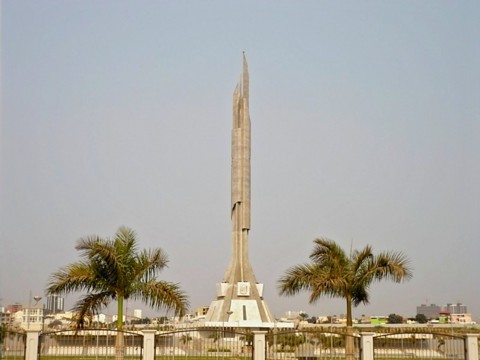
Angola is one of those places in the world that brings with it a sense of mystery, a sense of curiosity and a sense of fear of the unknown. To most people, little is known about Angola. You may know they recently came out of a decades long civil war. If you’re a sports fan, you may remember Angola for the being the first country the original Dream Team played at the Barcelona 1992 Olympics where they lost by some 60 points to Michael Jordan and company. Or perhaps you may know that Angola hosted last year’s Africa Cup of Nations and it was marred by the shooting of the Togo National Team bus in the exclave province of Cabinda. You may know they are the largest producer in all of Africa; even bigger than Nigeria. You may know they have one of the most corrupt governments on Earth. You may know that Angola is considered the worlds most expensive country and Luanda the worlds most expensive city. You may know one or two of these things but likely, you’ve never even heard of Angola, Cabinda or at least have never paid any attention. That appears to be just how the government wants it though.
Angola is a big country made up of some 18 provinces on the southwest coast of Africa. Its dealings with the outside world have been very limited to business, namely oil. To say that oil is big in Angola is an understatement. Angola is oil. It is essentially run by the big western oil companies that exploit the natural resources and cheap labor with a little help from the ever encroaching Chinese. And of course a corrupt government who takes all the oil riches and sticks it right in their own pockets while their people starve. This, my friends, is modern day Africa, like it or not. It is just the way it works down here.
Governments is Africa, especially in oil rich countries on this part of the continent do not exist to help their own people. They exist to squeeze every last cent out of companies like Exxon, Chevron, Total, Schlumberger, BP etc. That money, in the billions and billions of dollars every year, goes straight into the pockets of the corrupt politicians who have bled this country (and others like it-see Equatorial Guinea) dry for decades. Poverty is widely ignored and seemingly 90% of people in Angola live in squalor. I won’t post pictures of the poverty because I hate taking those pictures. Not because I am grossed out but out of respect for the poor people who cannot help themselves and whose government and people have abandoned them for personal gain and wealth. That said, here is my experience in Angola and Cabinda.
Those of you who follow my blog or Facebook know how difficult it has been to actually get a visa to visit Angola. The country doesn’t want tourists. The corrupt government only wants businesses and business people to come invest in the country so they can lace their Swiss bank accounts even more. The paranoia of the government of letting regular people in is laughable but believe you me; it does exist. For that reason it took me some 2 years of trying, not consecutively, but believe me, you cannot just send them your passport and get it back a few days later.
After contacting a company based in Luanda called Eco-Tur, run by a British National named Paul, who is an excellent person to know and use if you ever want to come to Angola, I was able to procure a visa. I had to book a personalized tour with Eco-Tur in order to get the visa invitation letter and then the letter of approval from the Ministry of Tourism here in Luanda. Believe me it’s a hassle but in the end I got it done thanks to Paul and his staff.
I arrived in Luanda a few days ago after a nightmarish long flight from New York to Johannesburg and on to Luanda. Flying into Luanda is like flying into a dust cloud and all you see is slums covered in dirt and dust for miles. Then you see the tons of oil tankers parked off the coast and you realize you have arrived. The airport itself is big, mainly stocked with military aircraft and helicopters. It reminded me of the Kabul airport a little. Once you get off the plane, you must wait in a long line for immigration, where they take their sweet time. Then as I finally got through I was greeted by my awesome driver, Neto.
Neto and I would become fast buddies and I really am going to miss driving with him. He was very funny and knowledgeable. He took me to check into the Soleme Guest House, which is half the price of most hotels in Luanda but still about $200 a night and very acceptable. It is popular with journalists and NGO types and was very pleasant. After dropping my stuff off, we headed straight out exploring the city, its sights and of course the traffic and dust.
Luanda may actually achieve my new distinction as having the worlds worst traffic. It is devastatingly slow and is almost everywhere. Like many cities in Africa and really around the world, the city was built for a few hundred thousand people and now there are millions and millions living here and the infrastructure cannot support the amount of cars on the streets. Luanda may also be the dustiest capital I have been to in Africa, and that’s saying something. You have to keep the windows up when driving or wear a bandana or something over your face or you’ll start coughing up dust and breathing dirt-trust me. Luanda is not a beautiful place.
As we made our way around town and he filled me in on the history of the place and the government, we ended up heading out to Ilha do Cabo, which is far and away the best part of Luanda. It is the beach area that forms sort of a cape around Luanda and creates the harbor where the ships come to port. It reminds me of Pointe Noire, Congo a bit with how it’s set up with beach bars dotting the sand and oil rigs and tankers in the background setting off the horizon nicely.
While quite nice in theory, and the place you would definitely hang out in if you lived here, they are augmenting the beaches with bulldozers and heavy equipment right now to accommodate the oil companies in some fashion that I wasn’t exactly clear on from the explanation I received. That aside, it is home to some of the city’s top restaurants, nightclubs and places to come and relax away from all the smog and congestion.
Aside from the Ilha, there are some scattered nice areas in town around the area of the Presidents Mansion and the embassies which is nice obviously. There are a few areas dotting downtown which include a Porsche and Land Rover dealership, which is something you don’t see too often in Africa and some oil company compounds and nice Chinese built buildings. That aside, it is a lot of slums and a lot of dust.
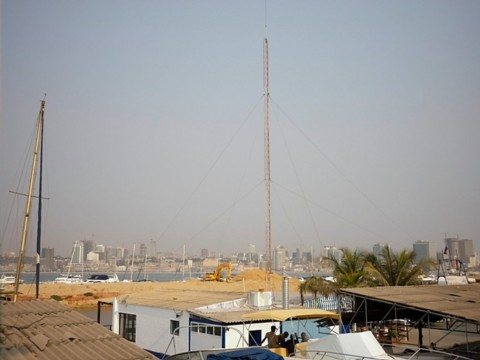
Luanda is a great example of a modern day African capital city. It is exploited and run by the west and the Chinese. It has a corrupt government and it has extreme poverty right next to the nicest parts of town. Again, like it or not, this is 21st century Africa and it’s not going to stop here, it will get much worse. The Chinese are coming so be ready.
If you don’t know about the Chinese taking over Africa, you should pay attention. Over the past few years, they have quickly developed alliances with African governments in exchange for cash, building infrastructure, airports, buildings, etc. Almost any African country you go to these days, you will see the Chinese in flocks of businessmen and you will see their flags on buildings or attached to land developments they are financing. This is all in exchange to take advantage of what will likely become a bloodbath of mineral and oil wealth exploration and exploitation of cheap labor and weak governments in the coming decades. It also gives the Chinese a reason to send their homeland people to work abroad. It will not stop; they are going to dwarf what the west has done over the past few decades.
As I have talked more here about Africa in general and corruption, I need to say a few other things about Luanda. The people who I have met and dealt with here have been amazing. They have been polite, accommodating, genuine and honest. I really appreciate that. I also had one of the best meals of my life here last night at this little Portuguese “tina”. It didn’t have a name but was located on the main road through town next to the Air 26 office which is a small airline here in Angola. The pepper steak I had last night while watching Barcelona beat Real Madrid was divine and I highly recommend it is you can find it! They also have $2 Cuca beers as opposed to $10-15 at the hotel and Cuca is pretty good.
Changing gears, tiny Cabinda is a place that you’ve only heard of if you’re an offshore driller or if you follow soccer and heard about the bus shooting last year during the African Cup of Nations where the Togo bus was shot up and a few coaches and staff were killed. That bus also was carrying former Arsenal and current real Madrid striker, Emmanuel Adebayor, who escaped unharmed but was really shaken up as you’d imagine. It is located north of the main area of Angola and in between a sliver of the Democratic Republic of Congo (DRC) and the Republic of Congo. Therefore, you need to actually leave Angola and go through DRC before reaching Angola which spells annoying, so fly or cross over from Pointe Noire in the Congo.
Cabinda, a lightning rod of Angolan politics and de facto independence, was added to the Travelers Century Club (TCC) list last year I believe sometime and has been a real thorn in the sides of many members who have already visited Angola. It is a pain in the ass to get to and you have to deal with the Angola visa of course as well. So many will pass but since I was here, it had to be visited.
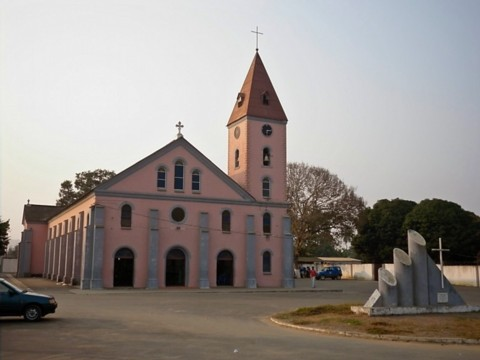
I flew up to Cabinda airport on the 45 minute flight on TAAG Angola Airlines very early in the morning. I was met at the airport by my guide and driver, Nelson, who was excellent and literally showed me everything in the exclave of Cabinda. The city of Cabinda itself is not much to talk about. The main attractions are the church and the big statue of Pope John Paul II (above and below respectively) along the beach front. Although quite pleasant, once you leave the city and head north, it gets much nicer in the cute smaller towns and there is no traffic.
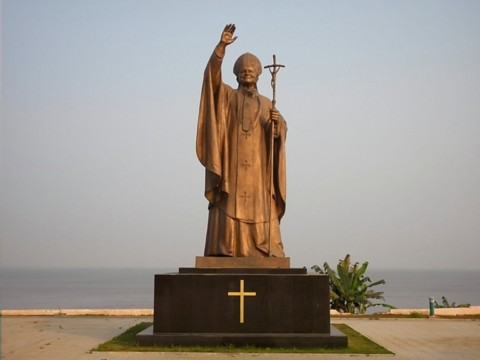
Leaving Cabinda City and heading north along the freshly paved highway you notice that on the left side is a constant and really long barbed wire fence right off the highway and blocking access to the coast. This is what’s called Chevron land. Chevron basically owns Cabinda which has the richest oil deposits in Africa. Basically a third of the entire exclave is fenced off. This is good and bad obviously. It is bad because it’s another example of the west exploiting Africa but it’s good because it gives jobs to many locals who would otherwise be working menial jobs in agriculture, if that.
Another thing about Cabinda that was cool for me was that they have this massive soccer stadium (below) which hosted some of the Africa Cup of Nations games last year. It was also the destination for the Togo team when their bus got shot up after crossing in from Pointe Noire where they were staying. I watched all those games on TV and it was cool to see it in person up close. It was a colossal waste of money as the stadium will likely be used only sparingly if at all again but it’s something to see and I love sports-even African soccer.
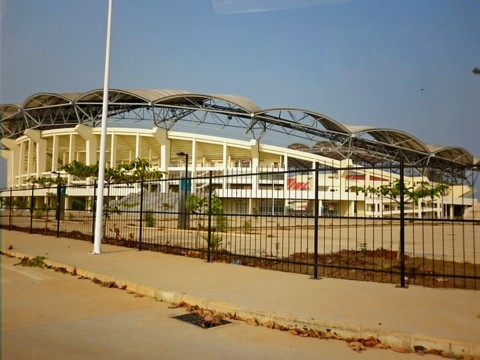
Cabinda is mainly tropical forest and has some nice lakes as you can see. My driver was great and knew all the best spots for pictures. We ended at the beach way up north where there were a bunch of restaurants and people selling fresh fish etc. It was a nice drive a great way to spend a day trip to Cabinda.
I had the perfect amount of time in Cabinda, 8 hours or so it was. There isn’t a ton to do (well hardly anything actually except drive around, have lunch and maybe see the beaches but the water is too cold to swim) and it’s very small. So if you ever find yourself with an intense desire to go there, do a day trip flight from Luanda or pass through from Pointe Noire. I am sure you all are going to head straight for the computer and book flights to Cabinda right away!
Anyway, my time in Angola and Cabinda has been well spent and action packed with very little downtime. I have been told and I have read how beautiful the rest of the country is and I have no doubt that it is spectacular as I have seen great pictures online. The issue is the cost of getting to places. If you want to do a thorough and comprehensive tour of Angola, it’ll cost you some $10,000. The cost of fuel, accommodation and service here is very high and makes it unappealing to leave the major cities. You’re better off going to neighboring Namibia or Botswana and doing it for much cheaper and some would say better. I wish I could have ventured outside of Luanda and seen the waterfalls and the nature parks but Cabinda gave me some sense of nature and the country.
I really enjoyed my time in this most interesting and telling country. It is a microcosm of modern day Africa and if you haven’t heard much about it, you will start to soon as they ramp up oil production and become a major global player. Hopefully they will allow tourism and have free elections soon because as my friend Neto said, 32 years as President is a lot for one man who doesn’t even help his own people when they are making billions.
The Internet connection in Windhoek where I am is so enragingly slow that I can only upload a few pictures…I will try and add more when I get to a better connection. I just wanted to get this up as I hate falling behind.


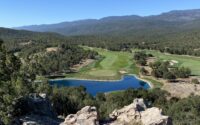
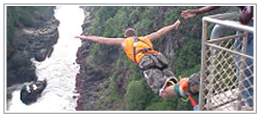








Lee, you have such an amazing way of telling it how you really see and believe places to be. I really enjoy reading your blog. Safe travels and I look forward to reading more.
Awesome post about a very unknown destination. Goodonya for making it thru Angola and Cabinda unscathed. Safe travels!
Incredible!
Good sh*t…love the way you write about the government corruption. More people need to do that kind of thing. Those guys get away with murder and the west just keeps feeding the beast…it ain’t right man!
Angola is rich country , I do remember those days were people had a tough time to travel from one province to another, now a days i can see all the freedom and excitment angolan people are enjoying now
life is like that up and down
I can’t wait to visit re-visit Angola. I left 37 years ago, miss the country ! Yea Cabinda is beautiful, i was there for 5 years, letf in October 30, 1975. Just applied for a visa in Washington DC. Have no idea when I will get back my passport with or without the visa. I had even bought a round trip ticket thinking it would be easy to get a tourist visa for 9 days. So far i have spent $2500 USD and nothing has happened. I guess my angolans friends will have to come to US to visit me, my doors are wide open!
Lee, I was in Cabinda a few days ago — still not much to see. Those seeking to complete the TCC list who didn’t visit Cabinda when they were in Angola must be kicking themselves — it’s hardly worth the return.
I spent three nights at Soleme — at $160 it passes for reasonable in Luanda.
I do agree it’s not worth traveling across the world to go and see it…I think crossing at Pointe Noire is the best and easiest route
I am a Nigerian and I am writing from Warri, Delta state, Nigeria. I want to enter Angola preferably by road using the Cabinda province as my entry route. How do I make the journey at a lesser cost.
I want to enter Angola to find work or employment to engage myself.
How do I start?
Hey Lee, and tips for getting in touch with your drivers in Angola? I have my visa, and will enter from Pointe Noire overland, then fly to Luanda. Names/phones/emails of drivers and hotels in both cities would be great!
Thanks!
I used a guy named Paul who runs Eco-Tur out of Luanda and he and his associate I believe whose name is Mario if I remember correctly arranged everything for me…I would look them up online and email them…good luck!
Thx for ur writing here! I will work in Cabinda from next year. Really hope that Cabinda will bring me many incredible things and everything there is quiet and safe!
What is actuall currency in angola?
Great visit report Lee (yes i know…. a few years late in responding 🙂 stay well Cheers Paul